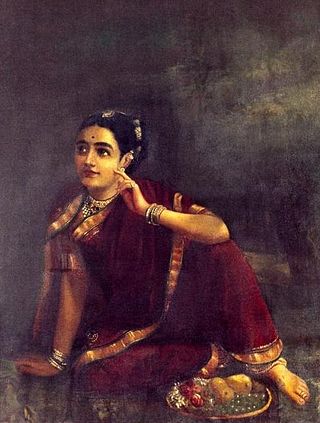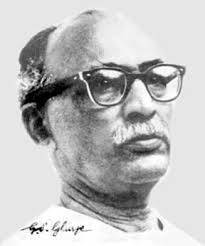
The Kiradu temples are a group of ruined Hindu temples located in the Barmer district of Rajasthan, India. Kiradu town is located in the Thar desert, about 35 km from Barmer and 157 km from Jaisalmer.

Mundum neriyatum is the traditional clothing of women in Kerala, a state in southwestern India. It is the oldest remnant of the ancient form of the sari which covered only the lower part of the body. In the mundum neriyatum, the most basic traditional piece is the mundu or lower garment which is the ancient form of the sari denoted in Malayalam as tuṇi, while the nēriyatu forms the upper garment the mundu. The mundum neriyatum consists of two pieces of cloth, and could be worn in either the traditional style with the nēriyatu tucked inside the blouse, or in the modern style with the nēriyatu worn over the left shoulder.

Sir Ramakrishna Gopal Bhandarkar, was an Indian scholar, orientalist, and social reformer.
In Hindu culture, a Pravara is a system of identity, particularly a family line. Pravaras is a particular Brahmin's descent from a rishi (sage) who belonged to their gotra (clan).

Chandrakala Anandrao Hate (1903–1990) was a writer, feminist, social worker, and professor in Bombay, India.

Koli Christians are subgroup of the Koli people, known as East Indians, the indigenous people of the Seven Islands of Bombay and the Bombay metro area, which is now also called Mumbai (Bombay). The Koli Christians were of the Son Koli caste, before theirforceful conversion by Portuguese from Brahmanism to Christianity, in the former Bom Bahia of Portuguese India. Christian Kolis are also known as Thankar and Gaonkar Kolis in Maharashtra, where they played an important role in building churches and convents in the northern Konkan division of Maharashtra.
TarkateerthaLakshman Shastri Joshi was an Indian scholar, of Sanskrit, Hindu Dharma, and a Marathi literary critic, and supporter of Indian independence. Mahatma Gandhi chose him to be his principal advisor in his campaign against untouchability. Joshi was the first recipient of Sahitya Akademi Award in year 1955. He was also awarded with two of the India's highest civilian honours Padma Bhushan in 1973 and Padma Vibhushan in 1992

Mandira dam is located near Kansbahal in Sundergarh district, Odisha, India. It is built across Sankh river, located 16 km upstream from Mandira. The water from the dam is used for Rourkela Steel Plant. Construction of the dam began after 1957. The dam displaced 2400 families and only 843 were resettled.
Marathi Brahmins are communities native to the Indian state of Maharashtra. They are classified into mainly three sub-divisions based on their places of origin, "Desh", "Karad" and "Konkan". The Brahmin subcastes that come under Maharashtra Brahmins include Deshastha, Chitpavan (Konkanastha), Saraswat, Karhade, and Devrukhe.

Taluka Haveli is a subdivision of the district of Pune, Maharashtra. The Pune Municipal Corporation & Pimpri Chinchwad Municipal Corporation, Pune are at the center of & entirely surrounded by the taluka for administrative purposes. The region of Pune Metropolitan Region has claimed the major part of the same.

The namasamkirtana, also rendered namajapa is the Hindu practice of congregational chanting of the names and other sacred expressions associated with a given deity. More commonly practised by members of the Vaishnava tradition, the namasamkirtana is characterised by devotees chanting the names of God in a religious gathering, in an expression of bhakti (devotion) and in a bid to achieve devotional ecstasy. This practice is regarded to have become popularised by the traditions that centred around Chaitanya, Vallabha, and Vithoba. The practice is regarded to be a common form of bhajana.
Vithal Krishnaji Khedkar was an Indian social reformer, one of the founders of the Prarthana Samaj in Bombay, and the author of a book later published as The Divine Heritage of the Yadavas, which was one of the earliest attempts to create a historical narrative for the Yadav caste of cowherds. His work made the case for a Yadav-Ahir narrative of descent from the god Krishna through royal dynasties. Khedkar's book was revised in 1924 by his son, the surgeon Raghunath Vithal Khedkar, and published in Allahabad in 1959.
Madhugiri Shamarao Anathapadmanabha Rao (1926–1985) was a professor of sociology who had been a founder-member in 1959 of the Department of Sociology at the University of Delhi, India. He wrote and edited extensively on subjects such as the social aspects of nutrition, both urban and rural sociology, the sociology of migration, and social dominance. He conducted much fieldwork as a part of his researches.
The Lonaria are an Indian caste historically associated with saltmaking, as well as production of lime, charcoal, and cement.
Gurjars or Gujjars are divided in number of clans (Gotras).They have as many as 1178 gotras.
Madhav Sadashiv Gore (1921–2010) was an Indian social scientist, writer, academic and the chancellor of Jawaharlal Nehru University, Delhi. He was the Director of Tata Institute of Social Sciences (TISS), the vice-chancellor of the University of Mumbai and a recipient of the Life Time Achievement Award of Indian Sociological Society.

Rahi, also called Rahimai or Radhamai, is the regional form of the Hindu goddess Radha. She is associated with the Vithoba (Vitthal) form of Hindu god Krishna in Maharashtra, India. According to the local legends, Rahi or Radhika is the wife of Vithoba. Indian sociologist G.S. Ghurye states that the regional form Rahi is derived from Radhika, another name of goddess Radha.
S. Devadas Pillai was an Indian sociologist.
The Son Koli, or Sona Koli is a subcaste of the Koli caste found in the Indian state of Maharashtra. The Son Kolis are the original residents of the Mumbai city which is subcapital of India. they follow the both religions of Hindu and Christian because Son Kolis were converted to Christianity during the Portuguese rule in India and worship the Our Lady of Mount and other Hindu deities. the Son Kolis are fisherman by profession for their livelihood.










